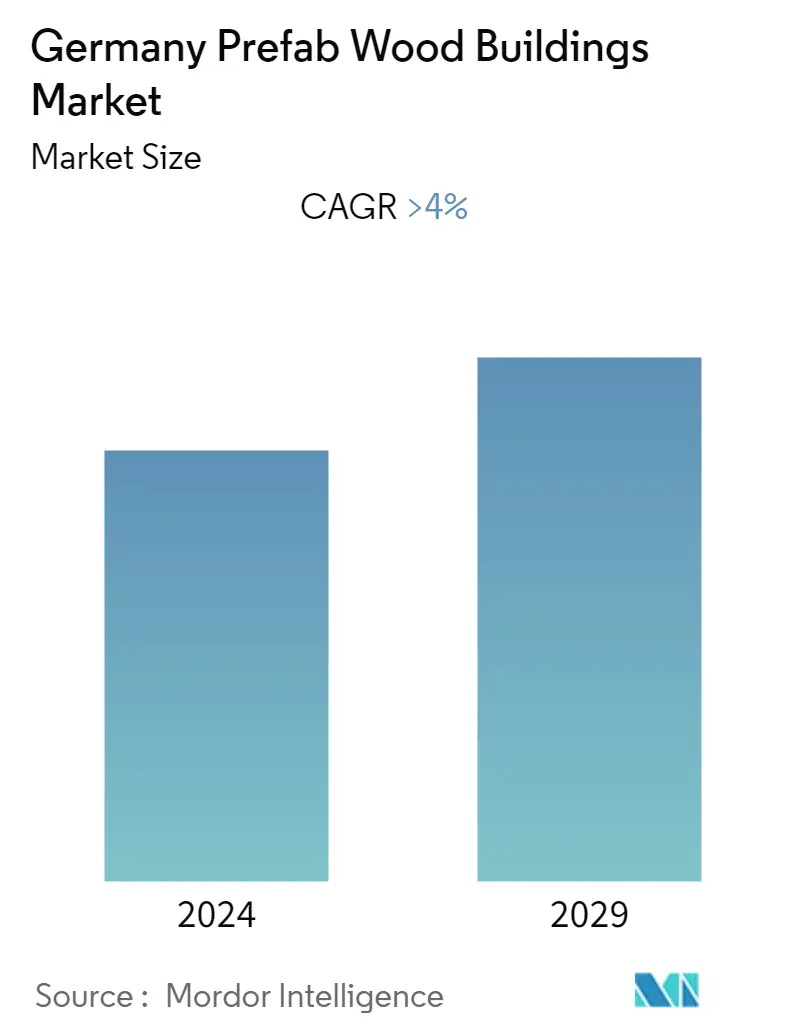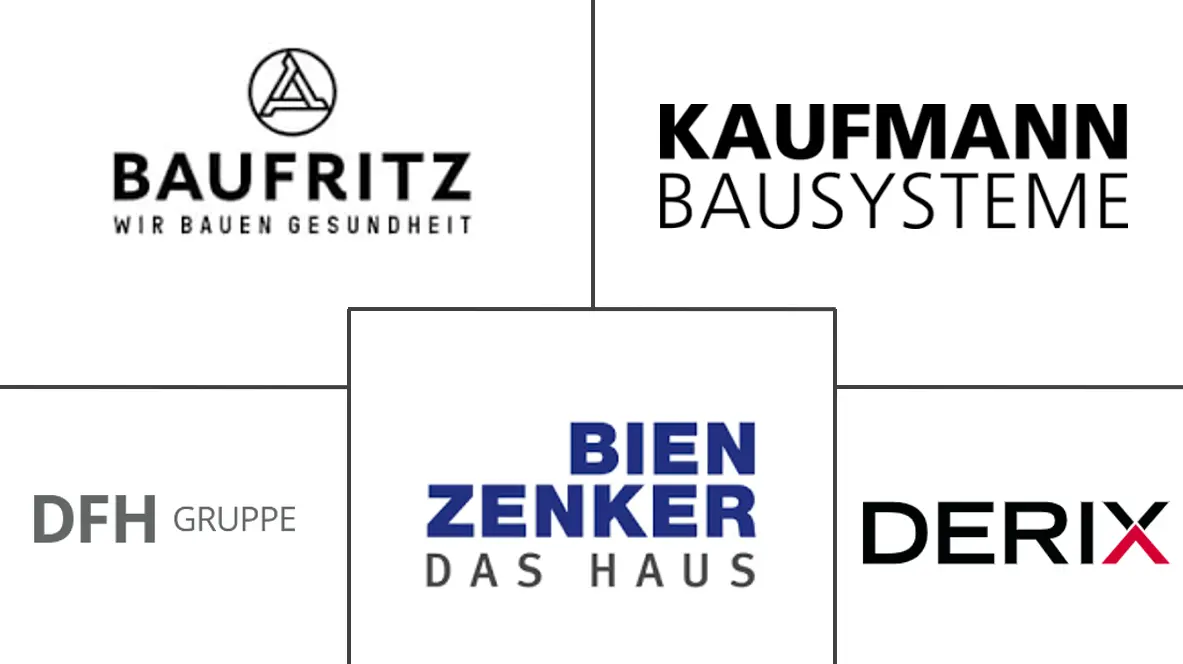Market Size of Germany Prefab Wood Buildings Industry

| Study Period | 2020 - 2029 |
| Base Year For Estimation | 2023 |
| Forecast Data Period | 2024 - 2029 |
| Historical Data Period | 2020 - 2022 |
| CAGR | 4.00 % |
| Market Concentration | Low |
Major Players
*Disclaimer: Major Players sorted in no particular order |
Germany Prefab Wood Buildings Market Analysis
The Germany Prefab Wood Buildings Market is expected to register a CAGR of more than 4% during the forecast period (2023-2028).
- COVID-19 has slightly impacted the prefabricated housing market in Germany. Due to COVID-19 restrictions, many construction projects were delayed or canceled. In addition, the pandemic has boosted offsite construction in the country, which offered improved safety, reduced risk, and greater certainty of completion on time and within budget.
- Germany witnessing a rise in timber construction, and out of five buildings constructed in the country, one is made of wood prefab modules. In addition, Berlin is becoming a hotspot for the wood prefab industry's growth. In September 2021, the German government planned to erect a seven-story office building made of wood, and the building is completely made of prefabricated wooden modules. This building is meant to provide offices for nearly 400 members of parliament.
- Moreover, timber structures are widely adopted in the country. For instance, in November 2022, EDGE Suedkreuz Berlin proposed a new concept of a sustainable future for building systems with timber. This project is a seven-story office complex consisting of two structures spread across more than 32,000 square meters.
- In addition, this project is one of the largest freestanding hybrid-timber projects in Europe. Also, in 2022, the German Sustainable Building Council (DGNB) designated the project as Germany's most sustainable building. Thus, the growing concerns about sustainability and increasing conventional construction costs will drive the timber prefabricated structures in the country.
Germany Prefab Wood Buildings Industry Segmentation
Wooden prefabricated buildings involve premade pieces that are constructed off-time. Prefabricated wood building kits, similar to life-sized Legos, are made up of prefabricated components that are delivered and assembled on-site. Furthermore, this report covers market insights, such as market dynamics, drivers, restraints, opportunities, technological innovation, its impact, porter's five forces analysis, and the impact of COVID-19 on the market. In addition, the report also provides company profiles to understand the competitive landscape of the market.
The Germany Prefab Wood Buildings Market is segmented By Panel Systems (Cross-Laminated Timber (CLT) Panels, Nail-Laminated Timber (NLT) panels, Dowel-laminated Timber (DLT) Panels, and Glue-Laminated Timber (GLT) Columns and Beams), and By Application (Single Family Residential, Multi-Family Residential, Office, Hospitality, and Others). The report offers market size and forecasts for the Germany Prefab Wood Buildings Market in value (USD billion) for all the above segments.
| By Panel Systems | |
| Cross-Laminated Timber (CLT) Panels | |
| Nail-Laminated Timber (NLT) panels | |
| Dowel-laminated Timber (DLT) Panels | |
| Glue-Laminated Timber (GLT) Columns and Beams |
| By Application | |
| Single Family Residential | |
| Multi-Family Residential | |
| Office | |
| Hospitality | |
| Others |
Germany Prefab Wood Buildings Market Size Summary
The Germany Prefab Wood Buildings Market is experiencing a notable expansion, driven by increasing adoption of timber construction and the growing emphasis on sustainability. The market is characterized by a shift towards offsite construction methods, which offer enhanced safety and cost-effectiveness. The COVID-19 pandemic has further accelerated this trend, as it highlighted the benefits of prefabricated structures in terms of timely and budget-friendly project completion. Berlin has emerged as a significant hub for this industry, with projects like the seven-story office building for parliament members and the EDGE Suedkreuz Berlin complex showcasing the potential of wooden prefab structures. These developments are part of a broader movement towards achieving net-zero emissions, with wood becoming a preferred material for various types of buildings, including residential, multi-family, and commercial urban structures.
Despite challenges such as high construction costs and material shortages, the demand for wooden prefab buildings continues to rise. The increasing prices of traditional building materials like wood, steel, and insulation have made prefabricated wood-based modules a more attractive option. This trend is further supported by initiatives like the construction of wooden schools in Berlin, which aim to reduce construction time and costs. The market is highly competitive and fragmented, with key players like W. u. J. Derix GmbH & Co., Kaufmann Bausysteme GmbH, and DFH Haus GmbH actively enhancing their offerings to meet evolving market demands. Partnerships, such as those between Knauf Group and Semodu AG, are also contributing to the development of innovative solutions in timber frame construction, reinforcing the market's growth trajectory.
Germany Prefab Wood Buildings Market Size - Table of Contents
-
1. MARKET INSIGHTS
-
1.1 Current Market Scenario
-
1.2 Insights on Technological Trends
-
1.3 Industry Value Chain/Supply Chain Analysis
-
1.4 Spotlight on Government Regulations and Key Initiatives in the Market
-
1.5 Brief on Different Structures Used in the Wood Prefab Buildings Industry
-
1.6 Market Dynamics
-
1.6.1 Drivers
-
1.6.2 Restraints
-
1.6.3 Opportunities
-
-
1.7 Porter's Five Forces Analysis
-
1.7.1 Threat of New Entrants
-
1.7.2 Bargaining Power of Buyers/Consumers
-
1.7.3 Bargaining Power of Suppliers
-
1.7.4 Threat of Substitute Products
-
1.7.5 Intensity of Competitive Rivalry
-
-
1.8 Impact of COVID-19 on the Market
-
-
2. MARKET SEGMENTATION
-
2.1 By Panel Systems
-
2.1.1 Cross-Laminated Timber (CLT) Panels
-
2.1.2 Nail-Laminated Timber (NLT) panels
-
2.1.3 Dowel-laminated Timber (DLT) Panels
-
2.1.4 Glue-Laminated Timber (GLT) Columns and Beams
-
-
2.2 By Application
-
2.2.1 Single Family Residential
-
2.2.2 Multi-Family Residential
-
2.2.3 Office
-
2.2.4 Hospitality
-
2.2.5 Others
-
-
Germany Prefab Wood Buildings Market Size FAQs
What is the current Germany Prefab Wood Buildings Market size?
The Germany Prefab Wood Buildings Market is projected to register a CAGR of greater than 4% during the forecast period (2024-2029)
Who are the key players in Germany Prefab Wood Buildings Market?
W. u. J. Derix GmbH & Co., Kaufmann Bausysteme GmbH , DFH Haus GmbH, Bien-Zenker GmbH and Baufritz are the major companies operating in the Germany Prefab Wood Buildings Market.

